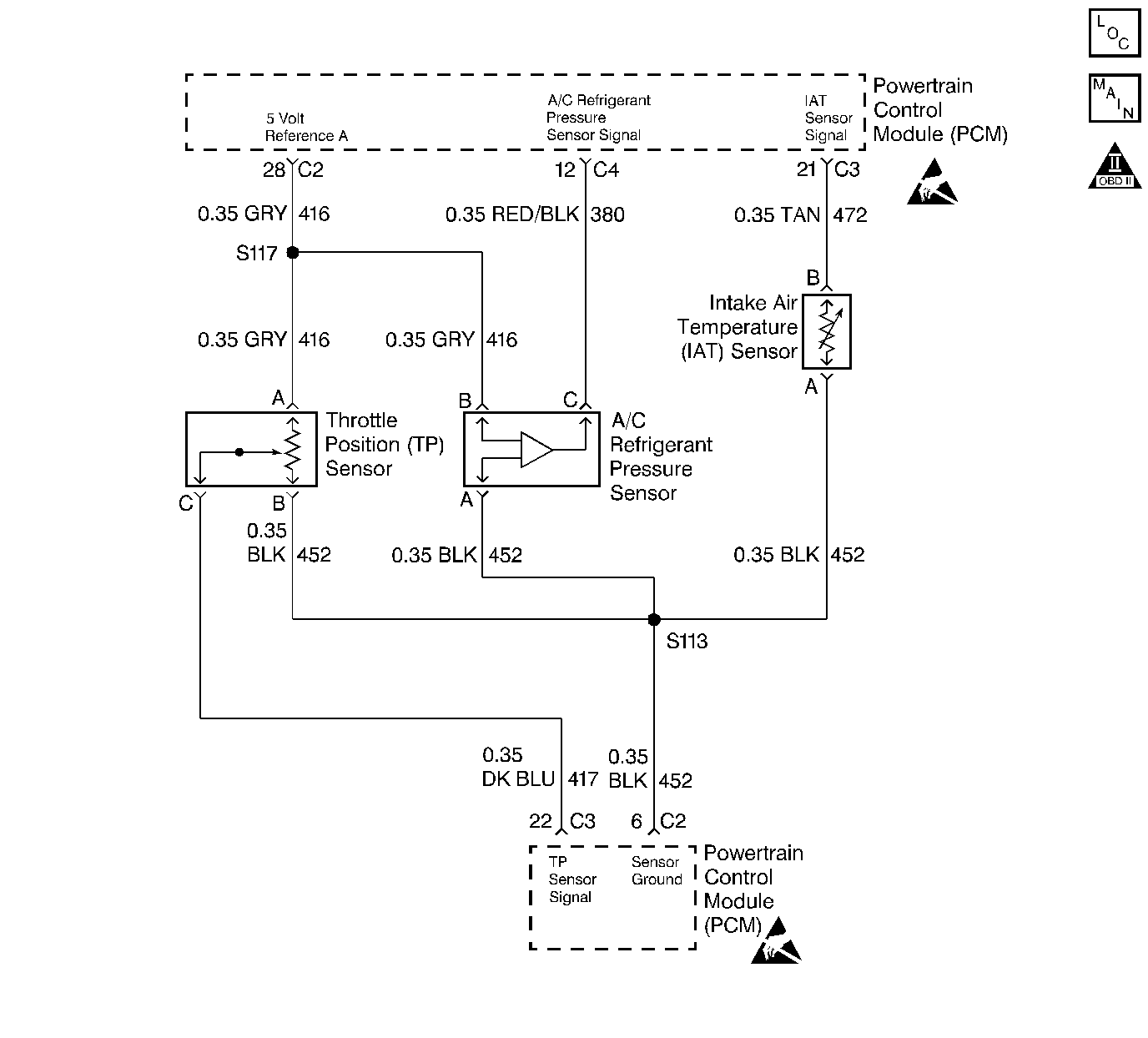
Circuit Description
The Intake Air Temperature (IAT) sensor contains a semiconductor device which changes resistance based on temperature (a thermistor). The IAT sensor is located in the air intake passage of the engine air induction system. The IAT sensor has a signal circuit and a ground circuit. The PCM applies a voltage (about 5.0 volts) on the signal circuit to the sensor. The PCM monitors changes in this voltage caused by changes in the resistance of the sensor to determine intake air temperature.
When the intake air is cold, the sensor (thermistor) resistance is high, and the PCMs signal voltage is only pulled down a small amount through the sensor to ground. Therefore, the PCM will sense a high signal voltage (low temperature). When the intake air is warm, the sensor resistance is low, and the signal voltage is pulled down a greater amount. This causes the PCM to sense a low signal voltage (high temperature).
When the PCM senses a signal voltage higher than the normal operating range of the sensor, this DTC will set.
Conditions for Setting the DTC
| • | DTC(s) P0100, P0102, P0103, P0117, P0118, P0500, P0502, P0503 not set. |
| • | Engine operating longer than 100 seconds. |
| • | Engine Coolant Temperature greater than 0°C (32°F). |
| • | Intake Air Temperature is less than -35°C (-31°F). |
| • | Vehicle speed less than 11 km/h (7 mph). |
| • | Mass Air Flow less than 15 grams per second. |
| • | All conditions met for 0.3 seconds. |
Action Taken When the DTC Sets
| • | The DTC will be stored in the PCM memory when the diagnostic runs and fails. |
| • | The Malfunction Indicator Lamp (MIL) will not illuminate. |
| • | The PCM will record operating conditions at the time the diagnostic fails. This information will be stored in Failure Records. |
Conditions for Clearing the MIL/DTC
| • | A history DTC will clear after 40 consecutive warm-up cycles, if no failures are reported by this or any other non-emission related diagnostic. |
| • | A last test failed (Current DTC) will clear when the diagnostic runs and does not fail. |
| • | PCM battery voltage is interrupted. |
| • | Using a scan tool. |
Diagnostic Aids
| • | If other DTCs are set that share the same ground and/or 5.0 volt reference circuit, check for faulty connections and for faulty wiring. |
| • | If the engine has been allowed to sit overnight, the engine coolant temperature and intake air temperature values should display within a few degrees of each other. If the temperatures are not within 3°C (5°F), refer to Temperature vs Resistance . |
For intermittents, refer to Symptoms .
Test Description
Number(s) below refer to step numbers on the diagnostic table.
-
If DTC P0113 failed this ignition, indicates a hard failure is present. When a hard failure is present, both the hard and intermittent DTCs will set.
-
When moving related connectors, visually/physically inspect connectors for the following:
-
When moving related wiring harnesses, visually/physically inspect wiring for the following:
-
Using Freeze Frame and/or Failure Records data may aid in locating an intermittent condition. If the DTC cannot be duplicated, the information included in the Freeze Frame and/or Failure Records data can be useful in determining how many miles since the DTC set. The Fail Counter and Pass Counter can also be used to determine how many ignition cycles the diagnostic reported a pass and/or a fail. Operate vehicle within the same freeze frame conditions (RPM, load, vehicle speed, temperature etc.) that were noted. This will isolate when the DTC failed. If this DTC runs and passes the diagnostic, the scan tool will not indicate any information under DTC Status.
| • | Poor mating of the connector halves or a terminal not fully seated in the connector body (backed out). |
| • | Improperly formed or damaged terminals. All connector terminals in the related circuits should be carefully reformed or replaced to insure proper contact tension. |
| • | Poor terminal to wire connection. Inspect for poor crimps, crimping over wire insulation rather than the wire. |
| • | Dirt or corrosion on terminals. Inspect connector seals for being there and for being damaged. |
| • | Wire insulation that is rubbed through, causing an intermittent short. |
| • | Wiring broken inside the insulation. |
Step | Action | Value(s) | Yes | No |
|---|---|---|---|---|
1 | Was the Powertrain On-Board Diagnostic (OBD) System Check performed? | -- | ||
Did DTC P0113 fail this ignition cycle? | -- | Go to DTC P0113 Intake Air Temperature (IAT) Sensor Circuit High Voltage | ||
Does the sensor value change abruptly while a related connector is being moved? | -- | |||
Using a scan tool, observe affected sensor value while moving related wiring harnesses. Does the sensor value change abruptly while moving related electrical harnesses? | -- | |||
Does the scan tool indicate that this diagnostic failed this ignition? | -- | Go to Diagnostic Aids | ||
6 | Repair damage connectors/terminals following Repair Procedures in Electrical Diagnosis (8A Cell 5). Is the action complete? | -- | -- | |
7 | Repair faulty wiring following Repair Procedures in Electrical Diagnosis (8A Cell 5). Is the action complete? | -- | -- | |
8 |
Is the action complete? | -- | -- | |
9 |
Does the scan tool indicate that this test ran and passed? | -- | ||
10 | Using the scan tool, select Capture Info, Review Info. Are any DTCs displayed that have not been diagnosed? | -- | Go to the applicable DTC table | System OK |
